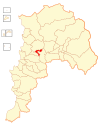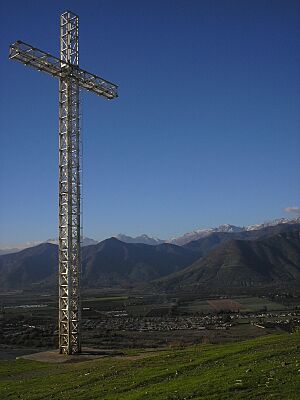La Calera, Chile facts for kids
Quick facts for kids
La Calera
|
||||
|---|---|---|---|---|

Downtown La Calera from the hills
|
||||
|
||||
| Country | Chile | |||
| Region | Valparaíso | |||
| Province | Quillota | |||
| Founded | 1844 | |||
| Government | ||||
| • Type | Municipality | |||
| Area | ||||
| • Total | 60.5 km2 (23.4 sq mi) | |||
| As of 2002 | ||||
| Elevation | 183 m (600 ft) | |||
| Population
(2012 Census)
|
||||
| • Total | 50,221 | |||
| • Density | 830.1/km2 (2,149.9/sq mi) | |||
| • Urban | 47,836 | |||
| • Rural | 1,667 | |||
| Demonym(s) | Calerano | |||
| Sex | ||||
| • Men | 24,134 | |||
| • Women | 25,369 | |||
| Time zone | UTC-4 (CLT) | |||
| • Summer (DST) | UTC-3 (CLST) | |||
| Area code(s) | 56 + 33 | |||
| Website | Official website: http://www.lacalera.cl/ | |||
La Calera is a lively city and commune located in the Quillota Province. It is part of central Chile's fifth region, called Valparaíso. This city has a rich history and plays an important role in the area.
Contents
Exploring La Calera's Location
La Calera is situated about 66 kilometers (41 miles) northeast of Valparaíso. It is also 118 kilometers (73 miles) northwest of Santiago. The city lies in the beautiful Aconcagua River Valley.
Geographic Borders and Size
The total area of La Calera is about 60.5 square kilometers (23.4 square miles). It shares its borders with several other towns. To the north and west, it borders Nogales. To the east, you'll find Hijuelas, and to the south, it borders La Cruz.
Major Roads Connecting the City
Important roads like Route 5 and Route 60 partly surround the city of La Calera. These routes help connect the city to other parts of Chile.
The Story of La Calera: From Limestone to City
The name "La Calera" comes from the Spanish word "cal", which means quicklime. This quicklime is made from limestone (piedra caliza in Spanish). People have been getting limestone from the hills south of the town for about 400 years. So, "La Calera" basically means "quicklime mine."
Early Beginnings and Jesuit Influence
The city started as a settlement created by the Jesuits. The land of La Calera belonged to them until 1767. This was when King Charles III of Spain ordered the expulsion of Jesuits. A Bavarian Jesuit missionary named Karl von Haimhausen was very important in developing the area early on.
Growth and Industrialization
A big change happened in 1842 when Bolivian citizen Ildefonso Huici bought the land. He was the father of the famous socialite Eugenia Errázuriz. Huici began to industrialize the area using local resources. By 1844, a small town had grown around the factories and production centers. This is how La Calera became the city it is today.
La Calera's Economy: A Hub of Activity
La Calera is located at an important crossroads in the central valley. Thanks to the hard work of local people and immigrants, it has become a key center for business and services in the Valparaíso Region. This is true even though it's not the capital city of its province. It also has a strong industrial base, providing many jobs for people in the surrounding rural areas.
Key Industries and Shopping Spots
La Calera is home to several important companies and shopping areas:
- Cemento Melón: A major cement company.
- Sopraval: A well-known company.
- Algamar: Another important business.
- Falabella Shopping Plaza: A popular shopping mall.
- Ripley Shopping Plaza: Another large shopping center.
People of La Calera: Demographics and Culture
In 2002, a census showed that La Calera had 49,503 residents. About 47,836 people (96.6%) lived in urban areas, and 1,667 people (3.4%) lived in rural areas. By 2007, the population was estimated to be around 50,644. La Calera's central location between Santiago de Chile and Valparaiso helped it become a hub for industrial growth.
Diverse Immigrant Communities
Before 1950, many immigrant communities settled in La Calera. The Palestinian and Italian communities are especially notable. La Calera has one of the largest proportions of Palestinian people in Latin America. Even a former mayor of the city was of Palestinian descent. Italian and French immigrants also helped create a successful farming economy.
Cultural Identity of Residents
La Calera has a mestizo cultural identity. This means that over half of the people have some Native American ancestry. It is estimated that people of Spanish descent and mestizos make up more than 90% of the population.
Famous People from La Calera
A person from La Calera is called a Calerano (for a man) or Calerana (for a woman). Some famous people from La Calera include:
- Eugenia Errázuriz
- Elías Figueroa Branden
- Manfred Max-Neef
How La Calera is Governed
As a commune, La Calera is a third-level administrative division of Chile. It is managed by a communal council (Concejo Comunal). This council is led by a mayor who is chosen by the people. The mayor, as of December 2008, was Dr. Eduardo Martínez Machuca from the Christian Democrat party.
Local Council Members
The communal council has several members who help run the city. These include:
- Trinidad Rojo (RN)
- Margarita Osorio (independent)
- Ricardo Aliaga (DC)
- Gustavo Arancibia (PS)
- Orietta Valencia (PRSD)
- Lautaro Correa (PS)
Representation in National Government
La Calera is part of the 10th electoral district for the Chamber of Deputies. Its representatives include Eduardo Cerda (PDC) and Andrea Molina (UDI). In the Senate, La Calera is part of the 5th senatorial constituency. Its senators are Ignacio Walker Prieto (PDC) and Lily Pérez San Martín (RN).
Universities in La Calera
La Calera is home to several universities and technical training centers:
- Universidad Aconcagua
- Universidad Bolivariana
- CTF Pontificia Universidad Católica de Valparaíso
See also
 In Spanish: La Calera (Chile) para niños
In Spanish: La Calera (Chile) para niños




